|
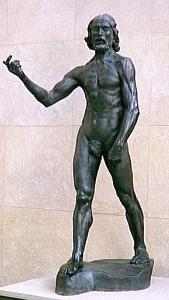 In 1877, Rodin began with first studies on a monumental sculpture of 'St.
John the Baptist Preaching'. Responding to the critics who had accused him
to have used casts after life for 'The
Age of Bronze' he modeled his figure larger than life-size.
In 1877, Rodin began with first studies on a monumental sculpture of 'St.
John the Baptist Preaching'. Responding to the critics who had accused him
to have used casts after life for 'The
Age of Bronze' he modeled his figure larger than life-size.
Rodin's interpretation of St. John the Baptist is that of a man preaching
while walking. Although both feet are fixed on the ground with the whole
sole - like in an Egyptian sculpture - the work procures the dynamic
impression of a man that resolutely goes his way. To his friend Paul
Gsell, Rodin later explained how he visualised two phases of a stride
simultaneously in order to suggest movement:
"Now, the illusion of life is obtained in our art by
good modelling and by movement.(..)
"Note, first, that movement is the transition from one attitude to
another. (...)
"You have certainly read in Ovid how Daphne was transformed into a
bay-tree and Procne into a swallow. (...) In each of them one still sees
the woman which will cease to be and the tree or birds which she will
become.
"It is, in short, a metamorphosis of this kind that the painter or
the sculptor effects in giving movement to his personages. He represents
the transition from one pose to another - he indicates how insensibly the
first glides into the second. In his work we still see a part of what was
and we discover a part of what is to be. (...)
"Now, for example, while my Saint John is represented with both
feet on the ground, it is probable that an instantaneous photograph from a
model making the same movement would show the back feet already raised and
carried forward to the other. Or else, on the contrary, the front feet
would not yet be on the ground if the back leg occupied in the photography
the same positions as in my statue."Now it is exactly for that reason
that this model photographed would present the odd appearance of a man
suddenly stricken with paralysis and petrified in his pose (..)
"If, in fact, in instantaneous photographs, the figures, though taken
while moving, seem duddenly fixed in mid-air, it is because, all parts of
the body being reproduced exactly at the same twentieth or fortieth of a
seconds, there is no progressive development of movement as there is in
art. (...)
"It is the artist who is truthful and it is photography which lies,
for in reality time does not stop, and if the artist succeeds in producing
the impression of a movement which takes several moments for
accomplishment, his work is certainly much less conventional than the
scientific image, where time is abruptly suspended.
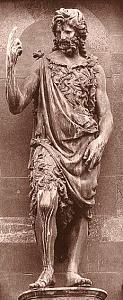 Rodin certainly was familiar with historical examples of statues of St.
John, like 'St. John the Baptist' by Giovanni Francesco Rustici
(Baptistery of Florence). Although the poses are very similar, Rodin shows his Baptist without
the traditional attributes of St. John - the sheepskin-coat and the cross.
His striding saint is nude, unidealized and crudely modeled. As could be
expected, the work met severe critique; most recipients found it improper,
even ugly and shocking.
Rodin certainly was familiar with historical examples of statues of St.
John, like 'St. John the Baptist' by Giovanni Francesco Rustici
(Baptistery of Florence). Although the poses are very similar, Rodin shows his Baptist without
the traditional attributes of St. John - the sheepskin-coat and the cross.
His striding saint is nude, unidealized and crudely modeled. As could be
expected, the work met severe critique; most recipients found it improper,
even ugly and shocking.
De Caso and Sanders describe Rodin’s 'St. John' as follows:
"The exaggeration of certain anatomical parts, like the
bulging muscles of back and arms and the ribs pushing through the chest,
anticipate sculptures like The Thinker. However, a difference in
proportions is apparent, for the St. John is slight and bony. The contrast
between muscularity and wiry build suggests the ascetic habits of the
desert dweller and the strength of his convictions. With his unusual
figure type and with the unique method for representing movement, Rodin
was able to create a sculpture with a forceful presence unlike anything
his contemporaries had ever seen."
Like for 'The Age of
Bronze', it was again the personality of the model that inspired Rodin
for 'The Baptist'. He once told Dujardin-Beaumetz: 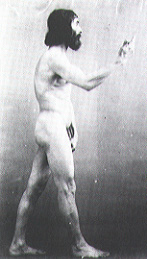
"One morning, someone knocked at the studio door. In
came an Italian, with one of his compatriots who had already posed for me.
He was a peasant from Abruzzi, arrived the night before from his
birthplace, and he had come to me to offer himself as a model. Seeing him,
I was seized with admiration: that rough, hairy man, expressing in his
bearing and physical strength all the violence, but also all the mystical
character of his race. I thought immediately of a St. John the Baptist;
that is, a man of nature, a visionary, a believer, a forerunner come to
announce one greater than himself."
There has been some controversy if it had been César
Pignatelli or rather his countryman Danielli who posed for the work.
Georges Grappe claimed that Danielli had been the model at least for the
head, hereby contradicting a statement by Truman Bartlett. A photo showing
Rodin's model Pugnatelli in the pose of 'The Baptist' seems to prove the
latter has posed at least for the body ; as for the head, even Grappe had
to admit there is only little resemblance between the 'Bust of Danielli'
and the face of 'St John'.
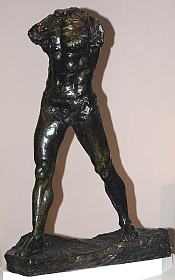 The
sculpture 'The Walking Man' is a version of 'St. John' without head and
arms, focused on the illustration of movement. During Rodin's lifetime,
'The Walking Man' was considered to be a preliminary study for the
complete 'Baptist', and mentioned in exhibition catalogues as such. Judith
Cladel, however, later recalled that Rodin created the 'Walking Man' only
after 1900, employing fragments from previous versions, deliberately
producing a partial figure. The
sculpture 'The Walking Man' is a version of 'St. John' without head and
arms, focused on the illustration of movement. During Rodin's lifetime,
'The Walking Man' was considered to be a preliminary study for the
complete 'Baptist', and mentioned in exhibition catalogues as such. Judith
Cladel, however, later recalled that Rodin created the 'Walking Man' only
after 1900, employing fragments from previous versions, deliberately
producing a partial figure.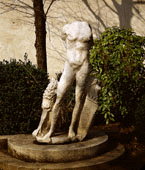
Albert Elsen and Henry Moore even suggested 'The Walking
Man' was made on purpose to look like an antiquarian sculpture rooted in
Roman and Greek art, without referral to the live model. Even if
Elsen and Moore were wrong, I determined a striking resemblance to the
sculpture 'Headless Hercules', which was placed in the garden of
Rodin's villa in Meudon ('Headless Hercules', Roman copy after a 4th c. BC
Greek original marble, 183 x 103 x 55 cm, MuRo Co.1107). Even the
different ways the arms have been broken off - leaving a stump at the
dexter side, while at the sinister side, the complete shoulder has been
truncated - is nearly identical in both cases. Rodin considered this
antique torso as the "jewel" of his collection, and once
commented:
"This Hercules, so proudly arched, stands there in the
most unaffected manner. He has been seized at a moment when nobody is
looking at him. Every single muscle is vibrating with the desire to
exercise, but no part of his being displays itself for admiration. It is
in this way too that antique art stands out so sharply from academic art
which claims, illegitimately, to be its descendant."
The headless 'st John' was exhibited for the first time
in Rodin's Pavillon at the Place d'Alma on a high column in 1900.
In 1905, the sculpture was enlarged to over-life size, the right shoulder
being bent slightly forward to amplify the suggestion of movement; only
from that time on, it became known as 'The Walking Man'. The
enlarged bronze version was exhibited for the first time in Strasbourg in
1907, and in the Paris Salon. One bronze cast was donated by
admirers to be placed at the Palazzo Farnese in Rome. Rodin, eager
to see his sculpture combined with the architecture created by
Michelangelo, travelled to Italy in January 1912 together with the
Duchesse de Choiseul and inspected the future site. After the
installation, the cast only stayed there till 1923 and was then returned
to Lyon, France, because it displeased the French Ambassor in Rome.
By now, there are several monumental casts in Museums worldwide.
BIBLIOGRAPHY (supplied by The
National Gallery of Art, Washington):
 Grappe, Georges. Catalogue du Musée Rodin. Paris, 1927: 50.
Grappe, Georges. Catalogue du Musée Rodin. Paris, 1927: 50.
 Cladel, Judith. Rodin: Sa vie glorieuse, sa vie inconnue. Paris, 1936:
146.
Cladel, Judith. Rodin: Sa vie glorieuse, sa vie inconnue. Paris, 1936:
146.
 Grappe, Georges. Catalogue du Musée Rodin. 5th ed. Paris, 1944: 64.
Grappe, Georges. Catalogue du Musée Rodin. 5th ed. Paris, 1944: 64.
 Summary Catalogue of European Paintings and Sculpture. National Gallery of
Art, Washington, 1965: 169, as Study for "St. John the Baptist,"
Gates of Hell.
Summary Catalogue of European Paintings and Sculpture. National Gallery of
Art, Washington, 1965: 169, as Study for "St. John the Baptist,"
Gates of Hell.
 Descharnes, Robert, and Jean-François Chabrun. Auguste Rodin. Lausanne,
1967: 85, 241.
Descharnes, Robert, and Jean-François Chabrun. Auguste Rodin. Lausanne,
1967: 85, 241.
 European Paintings and Sculpture, Illustrations. National Gallery of Art,
Washington, 1968: 149, repro., as Study for "St. John the
Baptist," Gates of Hell.
European Paintings and Sculpture, Illustrations. National Gallery of Art,
Washington, 1968: 149, repro., as Study for "St. John the
Baptist," Gates of Hell.
 Tancock, John. The Sculpture of Auguste Rodin. Philadelphia, 1976:
205-209.
Tancock, John. The Sculpture of Auguste Rodin. Philadelphia, 1976:
205-209.
 de Caso, Jacques, and Patricia B. Sanders. Rodin's Sculpture: A Critical
Study of the Spreckels Collection. San Francisco, 1977: 85-87.
de Caso, Jacques, and Patricia B. Sanders. Rodin's Sculpture: A Critical
Study of the Spreckels Collection. San Francisco, 1977: 85-87.
 Elsen, Albert E. "When the Sculptures Were White: Rodin's Work in
Plaster." In Rodin Rediscovered. Exh. cat. National Gallery of Art,
Washington, D.C., 1981: 130.
Elsen, Albert E. "When the Sculptures Were White: Rodin's Work in
Plaster." In Rodin Rediscovered. Exh. cat. National Gallery of Art,
Washington, D.C., 1981: 130.
 Vilain, Jacques. Claude Monet-Auguste Rodin: Centennaire de l'exposition
de 1889. Exh. cat. Musée Rodin, Paris, 1989: 189.
Vilain, Jacques. Claude Monet-Auguste Rodin: Centennaire de l'exposition
de 1889. Exh. cat. Musée Rodin, Paris, 1989: 189.
 Rosenfeld, Daniel G. Auguste Rodin's Carved Sculpture. Ph.D. diss.,
Stanford University, 1993: 413-417.
Rosenfeld, Daniel G. Auguste Rodin's Carved Sculpture. Ph.D. diss.,
Stanford University, 1993: 413-417.
|



 The
sculpture 'The Walking Man' is a version of 'St. John' without head and
arms, focused on the illustration of movement. During Rodin's lifetime,
'The Walking Man' was considered to be a preliminary study for the
complete 'Baptist', and mentioned in exhibition catalogues as such. Judith
Cladel, however, later recalled that Rodin created the 'Walking Man' only
after 1900, employing fragments from previous versions, deliberately
producing a partial figure.
The
sculpture 'The Walking Man' is a version of 'St. John' without head and
arms, focused on the illustration of movement. During Rodin's lifetime,
'The Walking Man' was considered to be a preliminary study for the
complete 'Baptist', and mentioned in exhibition catalogues as such. Judith
Cladel, however, later recalled that Rodin created the 'Walking Man' only
after 1900, employing fragments from previous versions, deliberately
producing a partial figure.